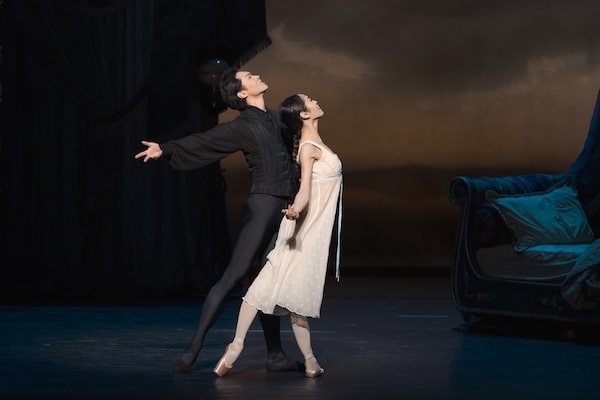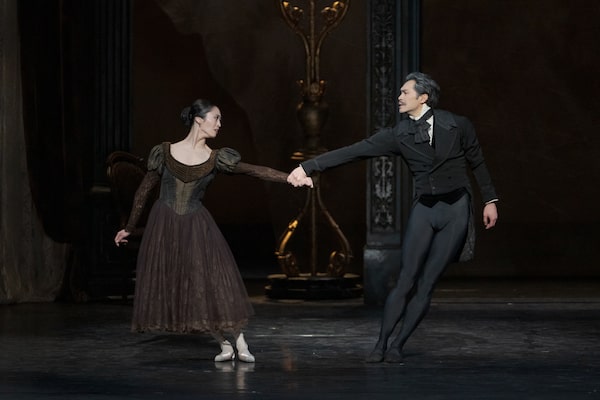
Koto Ishihara and Naoya Ebe in Onegin.Supplied
Keep up to date with the weekly Nestruck on Theatre newsletter. Sign up today.
- Title: Onegin
- Choreographed by: John Cranko
- Dancers: Various casting
- Company: National Ballet of Canada
- Venue: Four Seasons Centre for the Performing Arts
- City: Toronto
In the story ballet canon, there are terrible boyfriends, and then there is Eugene Onegin, the most toxically masculine leading man of all.
Consider the competition. Albrecht in Giselle cheats on his fiancée with a hot peasant. James in Le Sylphide cheats on his fiancée with a fairy. Prince Siegfried in Swan Lake? Easily beguiled by an evil temptress who can turn 32 fouettés.
And then there’s Onegin, who rejects the affections of a bookish young girl, ruins her birthday ball by dancing with her sister and then shoots his jealous best friend in a duel. The dude is one heck of a red flag, and now he’s back onstage at the National Ballet of Canada and harder to sympathize with than ever.
The company shares its sets and costume for this 2010 production of Onegin with the American Ballet Theatre, which will mount the same ballet this summer. One could argue that Onegin is the wrong story ballet for 2023: That in the post #MeToo era and after Putin’s invasion of Ukraine no one wants to spend 2.5 hours with an imperialist Russian. Ideally, both companies would explore a bit of narrative tweaking, but the reality is that familiar ballets sell tickets more easily than newer abstract work, and the National Ballet has limited options. It’s handy, so it’s back.
South African choreographer John Cranko created the ballet in 1965, one year after Vladimir Nabokov published his English translation of Alexander Pushkin’s Eugene Onegin. The original “novel in verse” was finished in the 1830s, the same decade when Pushkin himself died in a duel. The Russian-American choreographer George Balanchine wrote that, in English, “it’s difficult to explain the poem’s greatness,” but did his best by comparing Pushkin’s status in Russia with Shakespeare’s in the anglophone world.

Principals Naoya Ebe and Koto Ishihara partner well and have the steps down, particularly during a dream sequence duet that wonderfully mimeographs the act of falling in love.Supplied
More famous than the ballet is an opera by Tchaikovsky based on the novel – though the ballet is set to orchestrations of lesser-known works by The Nutcracker and Swan Lake composer, including solo piano pieces. If either company ever has the money, fresh arrangements are overdue. The constant clanging of the triangle could surely wake Tchaikovsky from his grave.
At this point, it’s only Cranko’s choreography, particularly the varied pas de deux and lively ensemble dances for the corps de ballet, that redeem this production. There are five principal roles, and a highlight of the five-day run at the Four Seasons Centre was watching four company dancers make their Onegin debuts at Thursday’s matinee.
Principals Naoya Ebe and Koto Ishihara made solid appearances as Onegin and Tatiana, the young wealthy Russian who falls for him when he visits her family’s country’s estate. They partner well and have the steps down, particularly during a dream sequence duet that wonderfully mimeographs the act of falling in love.
Cranko employs unique transitions in and out of lifts: She trust falls into his arms on one foot, and he hoists her from the floor in a split. To the audience, the aloof visitor who scoffs at her book is a jerk, but to Tatiana he’s an enigma. He does dance with her once in real life, when he first arrives. But that’s just Onegin’s way. “He quickly learned to make hearts flutter,” Pushkin wrote (Tom Beck’s translation). “When he danced he turned and twirled, his light mazurka no exception.”
Ebe’s acting performance, however, was mostly one-note, honing in on Onegin as a bored and brooding Byronic hero. But the poem also paints him as a “learned man” who “could hold his own in conversation.” Those virtues were not conveyed, leaving Ishihara’s Tatiana looking rather pathetic. (Ballet patrons with a history of youthful unrequited love will feel the cringe.)
Tatiana’s eventual husband, Prince Gremin (Ben Rudison at all but one performance) was a doting and reliable partner. Their pas de deux at an Act III ball has her fall off two toes straight into his secure arms, as compared with the derring-do duet with Onegin.
Emerson Dayton was buoyantly beautiful as Olga, Tatiana’s more confident sister. Keaton Leier, another corps dancer with gorgeous lines, comported himself well as her beau Lensky. The company needs more tall men who can partner well, and Leier has the potential to grow into this and other lead roles if his dancing takes on more ease and elegance.
In scenes for the corps, Cranko offers three contrasting ensemble dances: a peasant frolic, a courtly birthday partly and an extravagant St. Petersburg ball. The National Ballet has a number of corps men who are explosive jumpers, and their entrance in the Act I peasant dance was more fun than The Nutcracker trepak. The women were a bit shaky and out of sync in their opening scene, but rallied well for the birthday party dance, where eight pairs cross the stage twice while executing a series of forward-facing grand jetés.
In the final pas de deux, a remorseful Onegin and a more resilient Tatiana reprise the dream sequence choreography with a different power dynamic. He’s desperate for her affection; she’s fighting attraction. For the audience, the combination is pretty great, but for the relationship, Onegin’s attitude adjustment has come too late.
Tatiana banishes him from her home, and the curtain closes with Onegin headed to that special place in ballet hell reserved for all the leading men who do their women wrong.
In the interest of consistency across all critics’ reviews, The Globe has eliminated its star-rating system in film and theatre to align with coverage of music, books, visual arts and dance. Instead, works of excellence will be noted with a critic’s pick designation across all coverage. (Television reviews, typically based on an incomplete season, are exempt.)